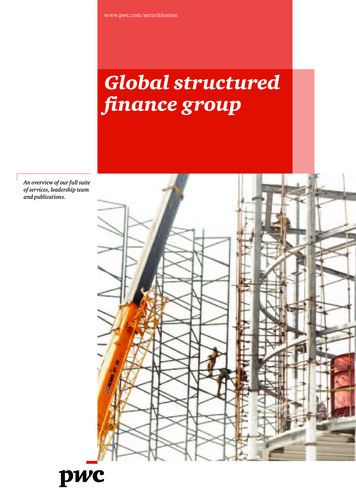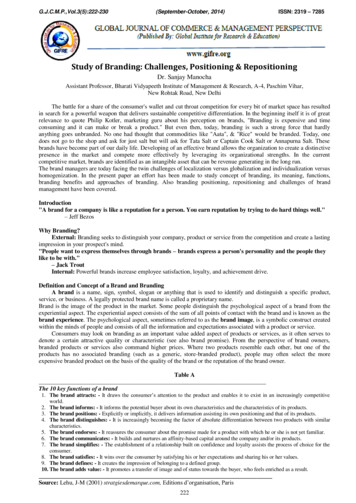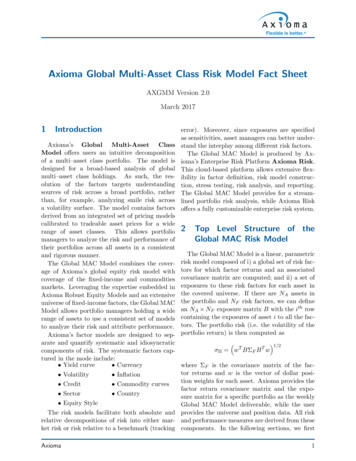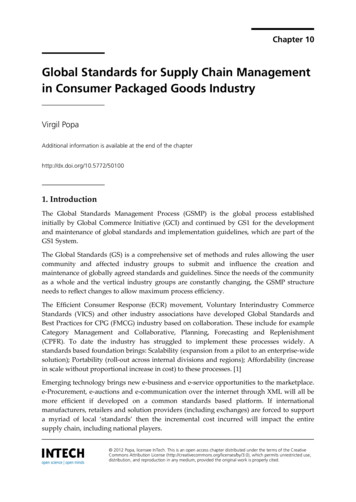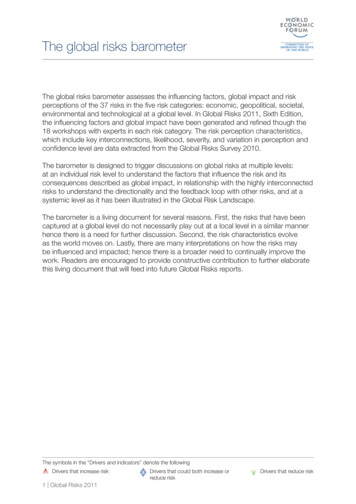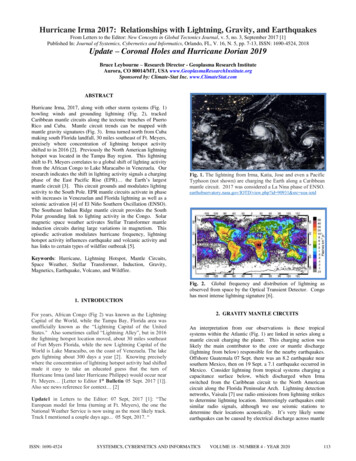
Transcription
Hurricane Irma 2017: Relationships with Lightning, Gravity, and EarthquakesFrom Letters to the Editor: New Concepts in Global Tectonics Journal, v. 5, no. 3, September 2017 [1]Published In: Journal of Systemics, Cybernetics and Informatics, Orlando, FL, V. 16, N. 5, pp. 7-13, ISSN: 1690-4524, 2018Update – Coronal Holes and Hurricane Dorian 2019Bruce Leybourne – Research Director - Geoplasma Research InstituteAurora, CO 80014/MT, USA www.GeoplasmaResearchInstitute.orgSponsored by: Climate-Stat Inc. www.ClimateStat.comABSTRACTHurricane Irma, 2017, along with other storm systems (Fig. 1)howling winds and grounding lightning (Fig. 2), trackedCaribbean mantle circuits along the tectonic trenches of PuertoRico and Cuba. Mantle circuit trends can be mapped withmantle gravity signatures (Fig. 3). Irma turned north from Cubamaking south Florida landfall, 30 miles southeast of Ft. Meyers,precisely where concentration of lightning hotspot activityshifted to in 2016 [2]. Previously the North American lightninghotspot was located in the Tampa Bay region. This lightningshift to Ft. Meyers correlates to a global shift of lighting activityfrom the African Congo to Lake Maracaibo in Venezuela. Ourresearch indicates the shift in lighting activity signals a chargingphase of the East Pacific Rise (EPR) the Earth’s largestmantle circuit [3]. This circuit grounds and modulates lightingactivity to the South Pole. EPR mantle circuits activate in phasewith increases in Venezuelan and Florida lightning as well as aseismic activation [4] of El Niño Southern Oscillation (ENSO).The Southeast Indian Ridge mantle circuit provides the SouthPolar grounding link to lighting activity in the Congo. Solarmagnetic space weather activates Stellar Transformer mantleinduction circuits during large variations in magnetism. Thisepisodic activation modulates hurricane frequency, lightninghotspot activity influences earthquake and volcanic activity andhas links to certain types of wildfire outbreak [5].Fig. 1. The lightning from Irma, Katia, Jose and even a PacificTyphoon (not shown) are charging the Earth along a Caribbeanmantle circuit. 2017 was considered a La Nina phase of ENSO.earthobservatory.nasa.gov/IOTD/view.php?id 90931&src eoa-iotdKeywords: Hurricane, Lightning Hotspot, Mantle Circuits,Space Weather, Stellar Transformer, Induction, Gravity,Magnetics, Earthquake, Volcano, and Wildfire.Fig. 2. Global frequency and distribution of lightning asobserved from space by the Optical Transient Detector. Congohas most intense lightning signature [6].1. INTRODUCTIONFor years, African Congo (Fig 2) was known as the LightningCapital of the World, while the Tampa Bay, Florida area wasunofficially known as the “Lightning Capital of the UnitedStates." Also sometimes called “Lightning Alley”, but in 2016the lightning hotspot location moved, about 30 miles southeastof Fort Myers Florida, while the new Lightning Capital of theWorld is Lake Maracaibo, on the coast of Venezuela. The lakegets lightning about 300 days a year [2]. Knowing preciselywhere the concentration of lightning hotspot activity had shiftedmade it easy to take an educated guess that the turn ofHurricane Irma (and later Hurricane Philippe) would occur nearFt. Meyers [Letter to Editor 1st Bulletin 05 Sept. 2017 [1]].Also see news reference for context [2]Update1 in Letters to the Editor: 07 Sept, 2017 [1]: “TheEuropean model for Irma (turning at Ft. Meyers), the one theNational Weather Service is now using as the most likely track.Track I mentioned a couple days ago. 05 Sept, 2017. “ISSN: 1690-45242. GRAVITY MANTLE CIRCUITSAn interpretation from our observations is these tropicalsystems within the Atlantic (Fig. 1) are linked in series along amantle circuit charging the planet. This charging action waslikely the main contributor to the core or mantle discharge(lightning from below) responsible for the nearby earthquakes.Offshore Guatemala 07 Sept. there was an 8.2 earthquake nearsouthern Mexico, then on 19 Sept. a 7.1 earthquake occurred inMexico. Consider lightning from tropical systems charging acapacitance surface below, which discharged when Irmaswitched from the Caribbean circuit to the North Americancircuit along the Florida Peninsular Arch. Lightning detectionnetworks, Vaisala [7] use radio emissions from lightning strikesto determine lightning location. Interestingly earthquakes emitsimilar radio signals, although we use seismic stations todetermine their locations acoustically. It’s very likely someearthquakes can be caused by electrical discharge across mantleSYSTEMICS, CYBERNETICS AND INFORMATICSVOLUME 18 - NUMBER 4 - YEAR 2020113
(Fig. 3) and lithospheric (Fig. 4) circuits, when circuits arehighly charged with differences in capacitance.Fig. 3. Mantle gravity anomalies from GRACE satellite missiondata [8] indicate EPR polar and continental circuit connectionsto Catatumbo, Tampa Bay lightning anomalies, and SEIRconnections to the African Rift/Congo global lighting anomaliesin Fig. 2.3. GEOLOGIC SETTINGWithin the Eastern Gulf of Mexico lies the Florida Platform, abroad carbonate buildup that underlies the Florida Peninsulaand continental shelf [9]. The stratigraphic evolution of theFlorida Platform has been influenced primarily by eustaticchanges [10] in sea level and the local hydrographic regime.Early Ordovician quartzitic sandstones inter-bedded with shaleexhibit metamorphic and hydrothermal alteration signatures[11,12] and overlie an ancient Triassic rift system associatedwith the Florida Magnetic Anomaly (FMA) [13]. This featuregenerally trends East-NE to West-SW as indicated by volcanicbasement magnetic trends (Fig. 4) along what’s known locallyin Florida as “lightning alley”. These geomagnetic anomaliesprovide links to the core-mantle-boundary and conductivepathways for electrical grounding of lightning strikes from localgeomagnetic anomalies embedded within the overlyingcarbonate platform.Florida Lightning Alley Ancient Triassic RiftLightning Doubles Before 2004 HurricanesIn 2017 Florida had an increased hurricane risk during the LaNiña phase of El Niño Southern Oscillation (ENSO). Multipletropical systems (Fig 1) were charging Earth through mantleand lithosphere reactivated circuits (Fig 3 & 4). Seismicactivation [4] of ENSO occurs during Stellar Transformermantle circuit (Alternating Current – AC) switching at theSouth Pole [3]. The circuit switches from grounding lightning inthe African Congo along the Southeast Indian Ridge (SEIR),over to an East Pacific Rise (EPR) mantle circuit groundinglightning at Lake Maracaibo in Venezuela and Florida. Theswitching mechanism is speculatively linked to sustainedinternal polarity alignments to the local Interplanetary MagneticField (IMF). Both ridges are considered "hot circuits" in theStellar Transformer concept [3]. Also see: www.iascc.org/thescience. These dominant circuits also modulate the PacificDecadal Oscillation (PDO) and Madden Julian Oscillation(MJO) climate indices. Seismic activity as a proxy forgeothermal heat flux that explains 62% of the variation in theearth’s surface temperature is a significant finding [15].Update2 09 Sept, 2017 [1]: “Hurricane Irma is now headeddirectly toward the Ft. Meyers area, Hurricane Charlie in 2004hooked into the Gulf and tagged Ft. Meyers before it hit Tampa(Fig. 4), also a major lightning concentration area, much like Iexpect Hurricane Irma will, and much like the European modelis currently projecting. Lightning intensities also happened toincrease the year before on the Gulf Coast just before Katrinahit. If you look at Gulf Coast lightning strike data (Fig. 5),you'll see the Wiggins Arch, a subsurface magnetic anomalystretching from Mobile, AL to Wiggins, MS (Fig. 4) lit up bymore intense lightning (Fig. 5). This was the power side ofKatrina if you recall. Watch Irma and see if it has this expectedrelationship to 30 miles SE of Ft. Meyers.”4. LIGHTNING OBSERVATIONSAncient Triassic rift crustal circuits in southeastern U.S. (Fig. 4)were also reactivated in 2003, when lightning reached a millionstrikes per year, nearly double the previous 1996 - 2002 yearlyaverage (Fig. 6). Hurricane Charlie in 2004 (Fig. 4) took asimilar path, across the spot where Irma (2017) turned on the Ft.Meyers lightning hotspot. Later Hurricane Philippe (2017) alsofollowed a similar path striking into the Tampa Bay lightninganomaly. Hurricanes Charlie, Jeanne and Frances (2004)crossed the geomagnetic anomaly near Tampa Bay (Fig. 4)where the lightning anomaly is located in Fig. 7. The WigginsArch on the border of Alabama and Mississippi where intenselightning concentrations occur (Fig. 4 & 5) is where HurricaneCamille (1969), Katrina (2005) and Nate (2017) made landfall.WigginsArchBruce Leybourne, this author, who worked as a Geophysicistfor the Naval Oceanographic Office at Stennis Space Centerand lived in Bay St. Louis, MS when Katrina struck, providesanecdotal evidence:Possible Activated Geomagnetic AnomalyZones (in circles) and 2004 hurricane pathways.Fig. 4. Hurricane Tracks and Lightning Grounding Zones toMagnetic Anomalies in Ancient Triassic Rift trends in thelithosphere. (Magnetic Data USGS [14] modified).114SYSTEMICS, CYBERNETICS AND INFORMATICS1.) Pine trees were across the street from my home in Bay St.Louis, MS for several decades. Lightning destroyed them in2004. Katrina struck the next year in 2005.2.) Two stories of lightning strikes to vehicles reported in 2004,one in southern Louisiana on radio, the other in Bay St. Louis,Mississippi when overheard at an auto parts store. Both statedlightning destroyed vehicle radio and blew out at least one tire.Haven’t heard reports like that before or since.VOLUME 18 - NUMBER 4 - YEAR 2020ISSN: 1690-4524
Fig. 5. Intense lightning concentrations [16] occur whereHurricane Camille (1969), Katrina (2005) and Nate (2017)made landfall. Geomagnetic signature is coincident withWiggins Arch Fig. 4, on the border of Alabama and Mississippi.In a 2005 research proposal on “Florida Hurricane Shock fromLightning Activated Geomagnetic Anomalies” we identified theoverall problem with the following hypothesis: Multiplehurricane tracks inundating Florida during the 2004 season mayresult from grounding of the global electric circuit alonggeomagnetic anomaly trends. Increased lightning strikes, alonggeomagnetic anomalies may attract hurricanes thermally andelectromagnetically. The Tampa Bay-Lakeland region hasmore lightning strikes than anywhere in the USA (Vaisala, Pers.Comm.) and overlies a geomagnetic anomaly which 3hurricanes passed directly over (Fig. 4) during the 2004hurricane season.In 2003 and 2004 lightning strikesapproximately doubled from a previous yearly mean under,600,000 to over 1,000,000 (Fig. 6) within a 1 x 2 degree swathincluding the Tampa Bay and Lakeland region (Fig. 7 & 8).The majority of strikes north-northeast of Tampa Bay definesthe most conductive grounding within this area. Lightningpositive polarity strikes (Fig. 8) indicating ground affects, bythe charge lowering from the clouds, shifted inland and wereprimarily focused over a geomagnetic anomaly (Fig. 4) underLakeland.Hurricane Charley entered from the Gulf of Mexico passingover the Florida Canyon before passing directly over thesuspect Lakeland geomagnetic anomaly (Fig. 4), near Tampa.While Frances and Jeanne came from the Atlantic passinggeomagnetic anomalies associated with Abaco Islands in theBahamas before vectoring directly in on the geomagneticanomaly underlying Lakeland. Then both eyes passed directlyover the conductive zone associated with lightning grounding inFig. 7. Geomagnetic anomalies may provide conductive zonesalong other crossing areas of hurricane paths, like hurricaneIvan (Fig. 4) associated with earthquakes in Montana and likelytriggering seismic activity in Mt. St. Helens starting on 23September during the 2004 hurricane season. In 2005 seismicactivity continued in Mt. St. Helens with volcanic activitythrough 2008. The 2004/05 hurricane seasons were both verybrutal. Hurricane Andrew (1992) also made landfall along ageomagnetic anomaly trend in south Florida (Fig. 4). Thecommon denominator and unifying principal of this geologicalforcing function on climate is an internal joule heatingmechanism [17]. Electrical activation in the eastern Gulf ofMexico occurs from return circuit grounding of lightning strikesalong geomagnetic anomalies in central west Florida. Ourresearch efforts provide a tectonic electrical framework tounderstand these phenomena and create forecasting tools withina new theoretical framework considering effects of geomagneticinduction from solar coupling to the global electric circuit andEarth’s endogenous energy (3, 17).Fig. 7. Composite Lightning Strikes from Jan. 1996 to Oct2004. The majority of strikes North-northeast of Tampa BayGeospatially Correlate to the Eye Passage of HurricanesFrances and Jeanne [7].Fig. 6. Yearly lightning strike histogram provided by Vaisala.Indicates a near doubling of strikes in 2003 and 2004 fromearlier yearly means. Blue indicates strikes with positivepolarity [7].ISSN: 1690-4524Fig. 8. Positive Polarity Lightning Strikes Move Inland overGeomagnetic Anomaly Zones Provide Supporting Evidence forElectromagnetic Attraction of the Lakeland Region to 3Hurricanes [7].SYSTEMICS, CYBERNETICS AND INFORMATICSVOLUME 18 - NUMBER 4 - YEAR 2020115
5. EARTHQUAKES1st Bulletin in Letters to the Editor: 05 Sept, 2017 [1]: “Whythe 8.2 Guatemala earthquake manifested exactly where it did,is a bit more difficult to explain, but likely tied to mantleconductivity relationships and its close proximity to thecharging systems. Interestingly I've also seen hurricanes, whichhit the Appalachian Mts. trigger seismic excitement in volcanicsystems on the west coast (Mt. St. Helens). Keep your eye outfor this phenomena again, when Irma gets into north Georgia,you might see some seismic and/or volcanic activity triggeredon the west coast (See below: Update 3).”Update3 11 Sept. 2017 [1]: Article found by James “Mick”Davis, Director - IASCC: See item [18].Seismic activity was suspected out west from charging ofseveral tropical systems. In Idaho 204 earthquakes occurredsince 02 Sept. 2017 (Fig. 9). Update received 11 Sept. 2017.Fig. 9. 204 EARTHQUAKES SINCE SEPT. 02. Coloredsquares show earthquake epicenters that have occurred sinceSept. 2 in Southeast Idaho [18].(University of UtahSeismograph Stations.)The earthquake swarm in Southeast Idaho may be associatedwith the Yellowstone Super Plume and West Coast volcanicsystems. Earthquakes in Idaho were ongoing coincident withthe tropical cyclones. This was the earthquake signal I waslooking for out west. “Thus far the most powerful temblor inthe swarm was the second quake to occur. It was a 5.3magnitude earthquake and struck at 5:56 p.m. Sept. 2.Authorities say it has been years since Southeast Idahoexperienced a quake of 5.0 magnitude or greater. But in regardto the current earthquake swarm, authorities say SoutheastIdaho has never seen so many earthquakes in such a short timeframe” [18].6. EARTHQUAKES AND PACIFIC HURRICANES - 1983At 8:06 a.m. (MST) on Friday October 28, 1983 up tomagnitude 6.9 earthquakes rocked the towns of Challis andMackay, Idaho for 30 to 60 seconds. The quake originatedalong the Lost River Fault below Idaho’s tallest mountain,Borah Peak, at a depth of nearly 10 miles. The fault thrust theLost River Mountains upward while dropping the ThousandSprings Valley lower. Overall, the mountains and valley shiftedapart nearly 14 feet in some places. This was the largest andmost damaging earthquake in Idaho history [19].Pacific hurricanes track off the western coast of Mexico alongan extension of the East Pacific Rise (EPR) mantle circuit intothe California Baha (Fig. 3) and San Andreas Fault system. TheColorado/Green River system splays off the San Andreas116SYSTEMICS, CYBERNETICS AND INFORMATICSconnecting the Idaho Basin and Yellowstone earthquake regionsto EPR mantle circuits through deep faults systems followingthese rivers.Fig. 10. Seasonal Summary of Eastern Pacific Hurricanes [20].During the 1983 Pacific hurricane season (Fig. 10), 21 namedstorms appeared, well above the 15 long-term average. Lasting201 days, 1983 was the longest season on record. There were atotal of 1,238 storm hours, which was the most in four years[21]. When the Borah Peak earthquake occurred in October of1983, two category 4 hurricanes, Tico and Raymond, and onecategory 3 hurricane, Priscilla, occurred in October 1983 (Fig.10). A moderate El Niño was present throughout the season,with water temperatures across the equatorial Central Pacificnearly 5 F (0.6 C) above normal [22]. The Pacific DecadalOscillation (PDO) was in a warm phase during this time period.Both of these factors are known to enhance Pacific hurricaneseason activity [23]. The 1983 season was at that time the mostactive season in the Eastern Pacific Hurricane Center warningzone, but this record itself was surpassed during the 1985Pacific hurricane season, [24]. On September 19th, 1985 duringhurricane season, Mexico City was devastated by another 8.1magnitude earthquake that killed as many as 30,000 people andlevelled buildings across the city.Fig. 11 shows theAccumulated Cyclone Energy (ACE) in the Eastern Pacific(red) increasing in 1983 and peaking in 1985. Extensiveresearch is required to unravel these intricate relationshipsbetween lightning, earthquakes, cyclones and climate change.Fig. 11. This graph shows the development of AccumulatedCyclone Energy (ACE) by ocean basins. The figures are stackedon top of each other for each basin [25].7. BLAME IT ON EL NIÑO [26]Apparent dual thermal plumes above the Peru Trench off thecoast of South America in June 1997 signaled the beginning ofthe 1997/98 El Niño, and are correlated to earthquakes 7months prior in the trench on 15 Nov. 96 (Fig. 12). The 6 - 8month lag-time for Sea Surface Temperature (SST) anomalies(Fig. 12b & 12d) after this seismic event (Fig. 12e & 12f) arelikely related to thermal energy transmigrations time [27] ittakes heat to transfer from the base of the lithosphere at 33kmdepths. Shallow earthquakes at the base of the lithosphereclustered quickly within 2 – 3 days as seen in Fig. 12c.Earthquake data were found in National EarthquakeVOLUME 18 - NUMBER 4 - YEAR 2020ISSN: 1690-4524
Information Center (NEIC) data sets and are compared toNational Ocean and Atmospheric Administration (NOAA) SSTsatellite anomaly data (Fig. 12).Fig. 12. ENSO Seismic Activation Found [4], On Nov. 1996(a).Two distinct earthquake clusters appear off SouthAmerican Coast. (b). SST’s seem to emanate in a similar patternto the earthquake paired clusters. Northern SST anomaly is onthe continental shelf as is the northern earthquake cluster.Southern SST anomaly is further offshore (continental slope) asis the southern earthquake cluster. These SST anomaliesappeared (June 1997) just north of earthquake positionspossibly due to prevailing longshore currents, about 7 monthsafter the paired earthquake clusters. (c). Chart indicatesearthquakes/day (Frequency), magnitudes are added for simplepower indicator (Mag. Add), along with an average (Mag.Avg.) A spike in earthquake activity begins Nov. 12 th andtapers off Nov. 14th revealing events intense episodic nature.(d). SST Max. Anomaly/month indicating anomalies 7 C byJune 97 followed by a year of elevated SST anomaliesassociated with the 97/98 El Nino. (e). Joule energy releasedduring (f). Earthquake events occurred in Nov. 1996.Nov. 1996 also marked the beginning of a 22-year Hale solarcycle indicating a solar space weather coupling to theseclustered earthquakes. The source of these dual thermal plumesappear directly correlated to the dual seismic swarms ofclustered earthquake patterns (Figs. 12a and 12b). The northerncluster epicenter patterns appear on the continental shelfenvironment, while the southern cluster epicenters appear onthe slope. The two SST anomalies appear associated with thetwo separate (dual) earthquake clusters. The northern SST’sappear over the shelf, while the southern SST’s appear over theslope (Fig. 12b.). A large 7.7 magnitude quake was observedduring this event, triggering a small Tsunami in Hawaii(Walker, D.A., personal communication.).This authorhypothesized tectonic modulation of El Niño in 2001 [26].field around a conductive object. Usually a tall pointedstructure. Sailors observed this with religious awe andconsidered St. Elmo their patron saint as the phenomena oftenoccurs on ships, especially on ship’s masts duringthunderstorms.It has also been known to occur duringvolcanic eruptions. High voltage differentials between cloudsand ground must exist to create a local electric field ofapproximately 100 kV/m to induce a discharge in air. Thegeometry of an object controls the magnitude of the electricfield, as charge build up on sharp points lower the necessarydischarge voltage [28].These wildfire outbreaks generally occur during a period ofgeomagnetic storms caused by induction from solar coupling.Historical evidence from the most powerful space storm onrecord in September 1859, hints at the relationship to wildfireswhen telegraph wires shorted out in the United States andEurope, igniting widespread fires [29]. The strong solar storms(Coronal Mass Ejections – CME’s) that hit Earth in the finalweek of October 2003 were small in comparison to the 1859event, but may have electromagnetically induced an arcedshaped pattern of fires. The fire pattern follows crustalmagnetic anomaly trends arcing eastward just north of LosAngeles then southward around San Diego extending into theMexican Baja along the coast (Fig. 13) [5].Fig. 13. Arc-shaped fire pattern appears linked to geomagneticanomaly trends (insert).http://activefiremaps.fs.fed.us/fire imagery.php?firePick southern california & http://pubs.usgs.gov/sm/mag map/ mag s.pdfA closer look at the geology of the San Gabriel Mountains lyingbeneath the outbreak of a huge firestorm along its slopes revealsstrike-slip fault offsets with displacements up to 2 km (DayCanyon and Demens Canyon Faults) transecting crustalmagnetic anomalies of up to 800 nT, nanotesla (Fig. 14).8. ST. ELMO’S WILDFIRESWidespread California wildfire outbreaks in 2003 [5] and 2017occurred prior to and in conjunction with increased hurricaneseasons of 2004/05 and 2016/17 respectively. This sequence ofevents is also related to the electrical activation of East PacificRise mantle circuits manifest as St. Elmo’s fire.St. Elmo's fire is a glowing form of luminous bright blue orviolet plasma, similar to neon lights. It is created from theionization of nitrogen and oxygen molecules by the electricISSN: 1690-4524Fig. 14. Murray Fracture Intersects San Andreas Fault alongGeomagnetic Anomalies in San Gabriel Mountains, 800 lto/rialto.htmlSYSTEMICS, CYBERNETICS AND INFORMATICSVOLUME 18 - NUMBER 4 - YEAR 2020117
Consistent with Gregori’s theoretical discussions [17], thehypothesis of solar induced electrical wildfire propagation isunderstood in terms of comparatively deep earth e.m. inductioncoupled to coronal mass ejections creating the October 2003geomagnetic storms.The induction process originatesanomalous electric currents near the core-mantle- boundaryfrom the deep internal-geodynamo. Hotspots connect deepouter core circuits to electric circuits propagating into themantle and shallow lithosphere fractions of the Earth.Some of the geologic hotspots linked to California wildfire andearthquakes previously discussed are located at the GuaymasBasin Rift in the Gulf of California, the Hawaiian IslandHotspot, and mantle plumes related to the Yellowstone, IdahoBasin, Mt. St. Helens complex.Pacific fracture zones(Mendocino, Murray, Molokai) link shallow conductivepathways from the Hawaiian seamount chain to the U.S. Westcoast. The north-south polar circuit along the East Pacific Riseextends into the North American Continent continuing along theSan Andreas Fault System and completing circuits with otherfault systems and local magnetic anomalies such as those in theSt. Gabriel Mountains (Fig. 14) and splaying into theYellowstone, Idaho Basin, Mt. St. Helens complex. Caribbeancircuits are tied to the East Pacific Rise as shown in mantlegravity anomalies (Fig. 3) and into North America through theantenna of the Florida Peninsular Arch and deeper circuits ofthe Mississippi Embayment linked to the New Madrid SeismicZone and Great Lakes tectonic vortex. Voltage differencesbetween the these multi-level Earth circuits, cloud layers andthe ionosphere manifest St. Elmo’s fire as power line groundarcing, igniting combustible materials, destroying powersystems, and creating a firestorm along local magnetic trendsand fault patterns.8. CONCLUSIONSClimate oscillations of El Nino Southern Oscillation (ENSO)and the Pacific Decadal Oscillation (PDO) are linked to solarmagnetic variations (Fig. 15) and orbital phenomena effectingEarth’s magnetic field. Lunar cycles and orbital cycles of largerplanets like Jupiter and Saturn torque the center of the mass ofthe solar system creating turbulence within the Sun linked tosunspot cycles, magnetic variation, and climate change [30].Climate changes are linked to charging and discharging phasesof the Stellar Transformer [3] with resultant fluctuations ofEarth’s magnetic field in rhythm with the climate cycles.The lightning hot spot that shifted from Tampa to 30 miles SEof Ft. Meyers in 2016 was key to forecasting the turn of Irmatoward Ft. Meyers. Why? Intense lightning activity activatesand/or signals the activation of these lithospheric and mantlecircuits. At other times the hurricanes crossed Florida into theGulf discharging into the Tampa Bay lightning anomaly,following an ancient and shallower Triassic ridge circuit seen incrustal magnetic anomalies. There seems to be a simpleelectromagnetic attraction, as the hurricane must release itscharge and will do so intensely at already activated areas. Thehurricanes track these circuits (Fig. 3 & 4) when EM activity ishigh, when it’s stirred by the solar winds as indicated by thehigh solar Kp 7 index during this period driven by CoronalMass Ejection's (CME’s). The turn at Ft. Meyers indicated aswitching from the Caribbean circuit to one that follows theFlorida Peninsular Arch into the Appalachian trend, circuitsconnected to the New Madrid Seismic Zone. The International118SYSTEMICS, CYBERNETICS AND INFORMATICSEarthquake and Volcano Prediction Center (IEVPC) hasforecast large-scale ( 8.0) earthquakes to reoccur within thenext decade in New Madrid [31] as they did around 1812, inconjunction with a climate cold snap forecast from solar cycles[32, 33].Fig. 15. Magnetic Moment Decay (Top - John Quinn [3]) &PDO Climate Index (Bottom) are compared. Top figure reflectspast century of Earth’s magnetic moment decay field changes.Large curve trends correspond to global warming and coolingtrends reflected in the Pacific Decadal Oscillation (PDO) thelargest global temperature proxy. While smaller inflections areassociated with El Niño Southern Oscillation (ENSO). Bottomfigure shows Pacific Decadal Oscillation (PDO) warming trendsin red, cooling in blue moving in approximate 36-year rhythmwith the magnetic field changes.An innovative electro-dynamic model with a comprehensiveframework for understanding Earth’s interactions with spaceweather can be implemented with the “Stellar Transformer”concepts [3], with an improved understanding of the commonelectromagnetic denominators associated with space weatherhazards (Electro-Magnetic Pulse, EMP), communications,general every day and extreme weather events, i.e. hurricanes,tornadoes associated with the variable frequencies of climatechange, earthquakes, volcanoes, and certain types of wildfireoutbreaks associated with Coronal Mass Ejections (CME’s) [5].9. UPDATE- CORONAL HOLES ANDHURRICANE DORIAN 2019Excerpt From: Leybourne, B. A. and Orr, D., 2020, GlobalDisaster Forecasting with Space Weather and GeophysicalIntelligence, Proc. 11th International Multi-Conference onComplexity, Informatics, Cybernetics, (IMCIC 2020), Orlando,FL, March 2020, pp.55-60.HurricanesDo hurricanes intensify and stall out during earth facingsweeps of coronal holes?Multiple hurricane tracks inundating Florida may result fromgrounding of the global electric circuit along geomagneticanomaly trends [34] or “lightning hotspots” [35]. HurricaneIrma, 2017, along with other storm systems tracked Caribbeanmantle circuits along the tectonic trenches of Puerto Rico andCuba. Mantle circuit trends can be mapped with mantle gravitysignatures. Irma turned north from Cuba making south Floridalandfall, 30 miles southeast of Ft. Meyers, precisely whereconcentration of lightning hotspot activity shifted to in 2016VOLUME 18 - NUMBER 4 - YEAR 2020ISSN: 1690-4524
[35]. Previously the North American lightning hotspot was inthe Tampa Bay region. This lightning shift to Ft. Meyerscorrelates to a global shift of lighting activity from the AfricanCongo to Lake Maracaibo in Venezuela. Our research indicatesthe shift in lighting activity signals a charging phase of the EastPacific Rise (EPR) the Earth’s largest mantle circuit [36].This circuit modulates lighting activity and grounds to theSouth Pole. EPR mantle circuits activate in phase with increasesin Venezuelan and Florida lightning as well as a seismicactivation [37] of El Niño Southern Oscillation (ENSO). TheSoutheast Indian Ridge mantle circuit provides the South Polargrounding link to lighting activity in the Congo. Solar magneticspace weather activates mantle induction circuits during largevariations in magnetism. This episodic activation modulateshurricane frequency, the lightning hotspot activity influenceshurricanes [36].Case Study Hurricane Dorian 2019Hurricane Dorian stalled out at Category 5 intensity just beforeLabour Day, 02 Sept. 2019 (Fig. 16) grounding huge amountsof lightn
Hurricane Irma 2017: Relationships with Lightning, Gravity, and Earthquakes From Letters to the Editor: New Concepts in Global Tectonics Journal, v. 5, no. 3, September 2017 [1] Published In: Journal of Systemics, Cybernetics and Informatics, Orlando, FL, V. 16, N. 5, pp. 7-13, ISSN: 1690-45

